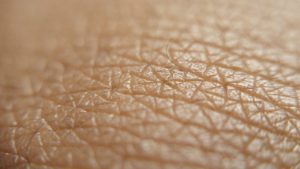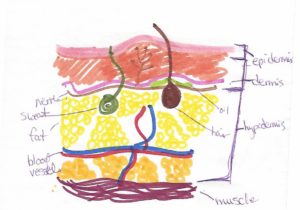How Sunscreen Works [Show Notes]

Two products to protect your skin from sun exposure
- Sunscreen – filters the sunlight *like a screen on a window*; made up of organic compounds (like chemistry, not vegetables) that absorb UVA and/or UVB rays that reach your skin. These are the products labeled with SPF numbers.
- Sunblock – used to be opaque because it is supposed to completely block any sunlight from getting to your skin. *Think Screech from Saved By The Bell*. Full of reflective particles to bounce the sunlight away from your body. The particles have been micronized by technology so it is transparent to your eyes, but not to the UV light from the sun.
Lesson on Light
The light comes from the sun. There’s visible light (ROYGBV) and that light bounces off of things and as it goes in your eyes, that’s how you can see things. Along with the light we see, there is ultraviolet light (waves of light that are shorter and more energetic that the violet color light). There are 3 types of UV light – 1 is absorbed and reflected by the atmosphere so it never makes it to us. Then there is UVA and UVB. UVA is more energetic and is most responsible for causing cell mutations that lead to cancer. UVB is less energetic and is most responsible for causing your skin to tan.

UV rays travel through these layers of the skin and stimulate the living and dividing cells to divide more and create more melanin. Reminder: melanin is your skin’s natural skin protectant because it will absorb UV rays in the higher layers to help prevent it from reaching the dividing cells.
SPF Math (Sun Protection Factor)
Step 1: find out how long you can be out in the sun without protection before your skin starts turning red or burning (example: 15 minutes)
Step 2: Multiply that “unprotected time” by the SPF number on the bottle (SPF 15) to get your “protected time” (15 x 15 = 225 minutes = 3 hr 45 min**)
**This is only if you don’t sweat and don’t get wet. But it’s very hard to be in the sun and NOT sweat. Plus your natural skin oils dilute it the longer it stays on the skin.
Protect Yo’self
The Skin Cancer Foundation recommends reapplying sunscreen every 2 hours no matter what. They also recommend that you use SPF 15 (or higher) sunscreen. It should block UVA and UVB. Use it every day, especially on your face, and use it all year round. The daily UV exposure, if you’re unprotected, is what they suspect leads to a greater chance of skin cancer.
They also recommend UV-blocking sunglasses.
Clothes and hats are the best way to protect your skin from sun exposure.
Stay inside during peak hours (10 am – 4 pm) of radiation (less atmosphere to block and deflect sunlight).
Do a monthly, head-to-toe, skin scan to check for new or changing moles, freckles, and skin tags (or get a friend to help). EARLY DETECTION!!
Have your doctor check your skin once a year.
Connect with me
Support us on Patreon
*NEW* Join the Pharmacist Answers Podcast Community on Facebook
Subscribe: iTunes, Stitcher, GooglePlay, TuneIn Radio
Music Credits: “Radio Martini” Kevin MacLeod (incompetech.com) Licensed under Creative Commons: By Attribution 3.0 http://creativecommons.org/licenses/by/3.0/


